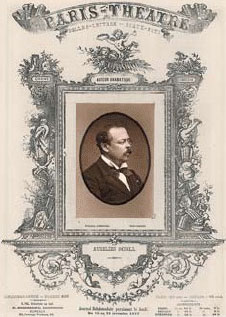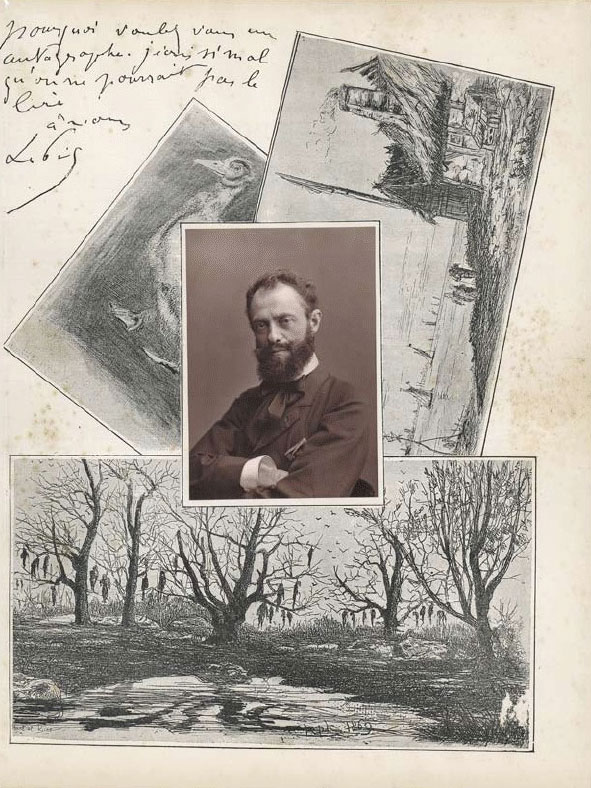- Relief printing
- Intaglio and planographic printing
- Color printing
- Bits and pieces
- Early photography in silver
- Non-silver processes
- Modern photography
- Color notes
- Color photography
- Photography in ink: relief and intaglio printing
- Photography in ink: planographic printing
- Digital processes
- Where do we go from here?
The woodburytype

Woodburytype. Etienne Carjat. Aurélien Scholl from Paris—Theatre (vol. 5, no. 235), November 15–21, 1877. 1887 (Printed by Lemercier et Cie). 3 1/2 x 5" (8.9 x 12.7 cm). The Museum of Modern Art, New York. Gift of Richard Benson. Although technically demanding, woodburytypes used cheap materials (and the cheap manual labor of the nineteenth century) and were often employed for theater bills and publicity for celebrities.
Chemically based photographic processes derive their color from characteristics of the chemicals used. Gold-toned albumen prints are purplish because that is the color produced by that particular chemistry. The carbon print avoids this restriction because it can be made with any pigment as its colorant. The woodburytype too has this freedom, since it is actually a cast replica of a carbon print, made out of the very same gelatin and pigment as the carbon original. I have little doubt that the woodburytype is the craziest process of them all. The carbon print varied in thickness according to the amount of hardened gelatin left on the print. Where a tone was dark, the pigmented gelatin was thick; where light, the layer was thin.

Woodburytype. Photographer unknown. Ludovic-Napoléon Lepic from Galerie Contemporaine. c. 1877. 17 5/8 x 10" (44.7 x 25.4 cm). The Museum of Modern Art, New York. Gift of Richard Benson. The small woodburytype has been pasted onto a sheet that has letterpress reproductions of drawings printed on it.
A woodburytype began with a carbon print, developed not onto a sheet of paper but onto a piece of glass. Once dry, the thin layer of gelatin—carrying all the modulations of height that derived from exposure—was pressed under extreme pressure into a sheet of lead, which took on the form of the gelatin (but as a negative, of course—thin where the gelatin was thick). This lead sheet was then used as a mold: hot, pigment-bearing gelatin was poured into it; a piece of paper, carefully manufactured to be of a consistent thickness, was placed on top of the hot gelatin; and the sandwich thus made—lead/gelatin/paper—was put in a press and squeezed. The excess gelatin ran out the sides, and after it cooled, a perfect print could be pulled off the mold.
The gelatin, bearing its pigment, then varied in thickness in exactly the same way that it had in the original carbon. The woodburytype plate was hard to make, but once done it could generate a lot of inexpensive prints. They curled terribly and the borders were always a mess, from the excess gelatin squeezing out, so they were always mounted. The woodburytype used no silver, which saved money, and it could produce monochromatic prints in any color, according to the pigment used. The prints were also never wet, so all the complex handling of wet paper was avoided. Most of them were colored to imitate albumen prints, so the viewers believed they were seeing a “real” photograph. The technology didn’t allow prints much bigger than eight by ten inches, but these beautiful little prints never had to go into a hypo bath so they are remarkably permanent. Woodburytypes were most often used for theater bills and popular magazines; the one on the previous page is from Galerie Contemporaine, a Parisian publication that was more or less the People magazine of its time. Both woodburytypes and their parent, the carbon print, sometimes show relief in the images when viewed along their surface in a hard light.

